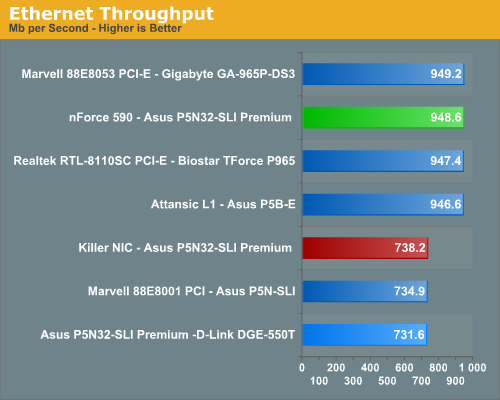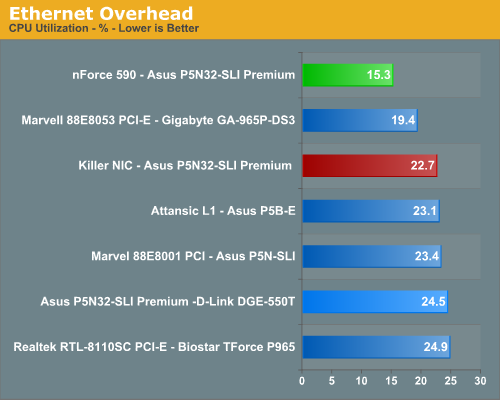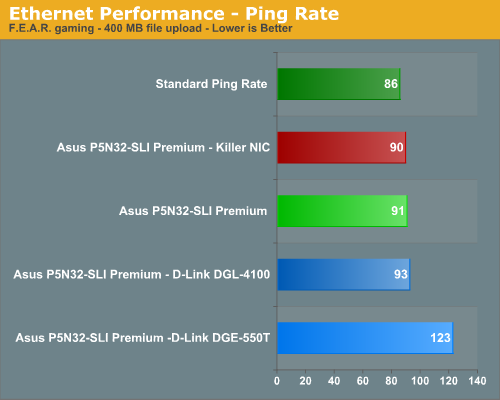BigFoot Networks Killer NIC: Killer Marketing or Killer Product?
by Gary Key on October 31, 2006 2:00 AM EST- Posted in
- Networking
Ethernet NIC Performance
Our current motherboard test suite includes LAN performance measurements and we will utilize this same test today. All of the boards listed utilize PCI or PCI Express based controllers with the only difference being the supplier of the core logic.
The Windows 2000 Driver Development Kit (DDK) includes a useful LAN testing utility called NTttcp. We used the NTttcp tool to test Ethernet throughput and the CPU utilization of the various Ethernet Controllers used on the Intel motherboards.
We set up one machine as the server; in this test, an Intel system with an Intel CSA Gigabit LAN connection. Intel CSA has a reputation for providing fast throughput and is a logical choice for our Gigabit LAN server.
On the server side, we used the following Command Line as suggested by the VIA whitepaper on LAN testing:


No real surprises here as the Killer NIC has a Marvell PHY and utilizes the PCI interface for operation. The throughput rates and CPU utilization of the Killer NIC was very competitive with our other PCI based solutions. However, the NVIDIA nForce 590SLI had the best overall performance numbers in these tests. BigFoot Networks was adamant about the fact they concentrated on lower latency and not improving throughput on the card since most network connections while gaming will not saturate the PCI bus.
Ethernet Outbound Ping Performance
Our final benchmark takes a look at the ping performance of each of our products while playing F.E.A.R. and uploading a 400 MB file to a separate client on another network. Our D-Link DGL-4100 router and the NVIDIA nForce 590SLI include packet prioritization for outbound traffic while gaming. We decided to see how well these solutions stacked up with the Killer NIC that can also prioritize inbound traffic.

All three of our products that advertise packet prioritization are within 3% of each other in the numbers with our D-Link DGE-550T trailing by around 33%. Why a serious gamer would actually want to upload large files while playing online is beyond us but in case you want to then our three solutions provide the capability to do so without an issue. However, be aware that throughput suffered by an average of 44% for the upload file test with our three solutions when compared to the D-Link NIC during testing.
Our current motherboard test suite includes LAN performance measurements and we will utilize this same test today. All of the boards listed utilize PCI or PCI Express based controllers with the only difference being the supplier of the core logic.
The Windows 2000 Driver Development Kit (DDK) includes a useful LAN testing utility called NTttcp. We used the NTttcp tool to test Ethernet throughput and the CPU utilization of the various Ethernet Controllers used on the Intel motherboards.
We set up one machine as the server; in this test, an Intel system with an Intel CSA Gigabit LAN connection. Intel CSA has a reputation for providing fast throughput and is a logical choice for our Gigabit LAN server.
On the server side, we used the following Command Line as suggested by the VIA whitepaper on LAN testing:
Ntttcpr -m 4,0,‹server IP› -a 4 -l 256000 -n 30000
On the client side (the motherboard under test), we used the following Command Line:Ntttcps -m 4,0,‹client IP› -a 4 -l 256000 -n 30000
At the conclusion of the test, we captured the throughput and CPU utilization figures from the client screen.

No real surprises here as the Killer NIC has a Marvell PHY and utilizes the PCI interface for operation. The throughput rates and CPU utilization of the Killer NIC was very competitive with our other PCI based solutions. However, the NVIDIA nForce 590SLI had the best overall performance numbers in these tests. BigFoot Networks was adamant about the fact they concentrated on lower latency and not improving throughput on the card since most network connections while gaming will not saturate the PCI bus.
Ethernet Outbound Ping Performance
Our final benchmark takes a look at the ping performance of each of our products while playing F.E.A.R. and uploading a 400 MB file to a separate client on another network. Our D-Link DGL-4100 router and the NVIDIA nForce 590SLI include packet prioritization for outbound traffic while gaming. We decided to see how well these solutions stacked up with the Killer NIC that can also prioritize inbound traffic.

All three of our products that advertise packet prioritization are within 3% of each other in the numbers with our D-Link DGE-550T trailing by around 33%. Why a serious gamer would actually want to upload large files while playing online is beyond us but in case you want to then our three solutions provide the capability to do so without an issue. However, be aware that throughput suffered by an average of 44% for the upload file test with our three solutions when compared to the D-Link NIC during testing.










87 Comments
View All Comments
rqle - Tuesday, October 31, 2006 - link
I never like to bash a company product because always believed there a niche market, but at its very best, this product doesnt seem to justified the $300 price cost. I do believe many would buy it at a lower price.My current broadband is 3.0mbps/512kb, i can pay $5 more a month more for Verizon Fiop 15mbps/2mbp, i would rather go that route for my improve network + other capibilities. As for the side processing function, a cheap $200 (Athlon64 3200+ computer system) can do a whole lot more. Am not saying it a bad product, it just price way to high for me.
cornfedone - Tuesday, October 31, 2006 - link
SOS, DD.Just as we've seen with Asian mobos in the last few years, this NIC card is an over-hyped, under-performing POS. Just as mobos from Asus, DFI, Sapphire, Abit, and more have suffered from vcore, BIOS, memory, PCI slot and many other issues, the BigJoke NIC card is more defective goods with zero customer support. I'm sure everyone looks forward to a wiped hard drive image... due to a poorly designed NIC card.
Sooner or later consumers are gonna wise up and stop buying these defective products. Until they vote with their wallet instead of their penis, unscrupulous companies will continue to ship half baked POS products and fail to provide proper customer support. If consumers stop buying these defective goods, then the company will either correct their problems or go tits up.
autoboy - Tuesday, October 31, 2006 - link
I didn't buy a NIC to make up for my small penis, I bought a Porsche. Chicks don't notice my NIC.The K does look pretty cool. Maybe it will fit on my Porsche.
Frumious1 - Tuesday, October 31, 2006 - link
I dare say few if any people have purchased AGEIA or Killer NIC cards. As for your whining about ASUS, DFI, etc. I guess you're one of the people running a budget $50 mobo that can't understand what it's like to really push a system? Or are you the other extreme: you overclocked by 50% or more and are pissed that the system wasn't fully stable?slashbinslashbash - Tuesday, October 31, 2006 - link
You talk a lot about how it's virtually impossible to test something whose entire performance is based almost entirely on an Internet connection which is inherently variable. That's why you need some more control over the variables in your test. Namely, a LAN.For example... have 4 computers, each with exactly the same configs except for the network cards. One of them has the KillerNIC, the rest have different NICs. They are all running Unreal Tournament. You also have one computer set up as the server, on the same Gigabit Ethernet switch as the 4 "player" machines. The level is a small plain square room with no doors, trenches, or any other features. Each of the "players" is running the same script where they have unlimited ammo and a machine gun, running circles around and around, shooting constantly from the minute they respawn. Let the scripts run for 100 hours and capture the framerate and pings on each machine.
So you have 4 computer players running around in circles in a small square room, shooting each other for 100 hours. Yes, there will still be randomness, but over the course of 100 hours it should cancel out, and this test should be replicable. Any real differences between the NICs would come out over time. Run it again to make sure.
Or maybe that's not the best way of doing it. I don't even play UT2003 so I don't know what's really possible and what's not, but I've heard of people doing scripts and stuff. Maybe there are better ways of doing it, but you can eliminate the variable of the Internet connection by limiting your testing to a LAN.
Gary Key - Wednesday, November 1, 2006 - link
We tested over a LAN, the results were not that different, in fact the NVIDIA NIC and Intel PRO/1000 PT cards had better throughput and latencies the majority of the time. We did not show these results as the card is marketed to improve your Online Gaming experience. If the card had been marketed as a must have product to improve your gaming capability on a LAN then it would have been reviewed as such.
When we tested on the LAN the steps you outlined were basically followed from a script viewpoint in order to ensure the variables were kept to a minimum. We did not provide these results, maybe we should have in hindsight. Our final opinion of the card would not have changed.
Thanks for the comments. :)
Frumious1 - Tuesday, October 31, 2006 - link
The product is targeted at gamers. Look at the marketing material. now, while a LAN party goer might get some advantage out of it, there are FAR more people playing games from home using broadband connections. If this only improves performance in a LAN environment (clearly NOT what is being advertised), then it's already a failure. I like what Gary did here: look at real world testing and let us know how it turned out. Who gives a rip about controlled environments and theoretical performance increases if the reality is that the product basically doesn't help much? What's really funny is that they even show a ping "advantage" in FEAR of maximum 0.40ms and average 0.13ms. WTF!? Like anyone can notice a .13ms improvement in ping times! The frame rate improvements might be good (if they were available in many games)... still not $270+ good, though.Bladen - Tuesday, October 31, 2006 - link
Or as you touched on, do the test for a long time, or many many repeats, and let the averages soeak for themselves.shoRunner - Tuesday, October 31, 2006 - link
You pay almost $300 for the ultimate NIC card, and its PCI so it can't even get anywhere near gigbit throughput. AND the CPU utilization isn't even better than an onboard solution. PLEASE. If anyone is truely thinking about buying this, send me a PM I've got some beautiful ocean front property in Montanta to sell you for pennies on the dollar.mlau - Tuesday, October 31, 2006 - link
You underestimate this card greatly. This is the ultimate network card for linux:it could theoretically offload almost all of linux' network stack (including linux'
advanced filtering/routing capabilites and protocols). It's a firewall-router on a
card. IMHO the card is targeted for the wrong crowd (although I understand it somewhat,
since gamers are usually stupid enough to buy 2 video cards and other completely
unnecessary stuff [ageia comes to mind])